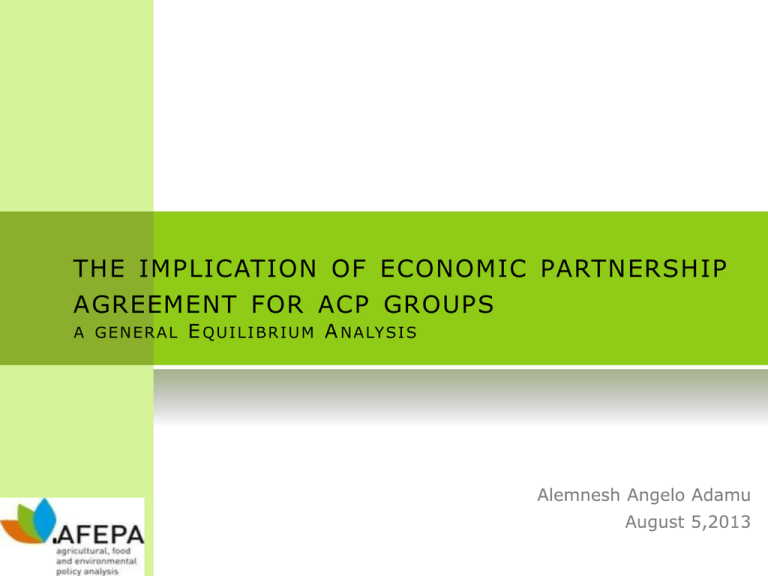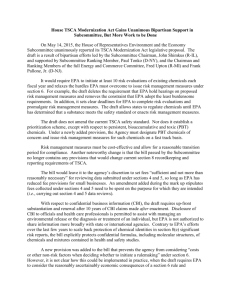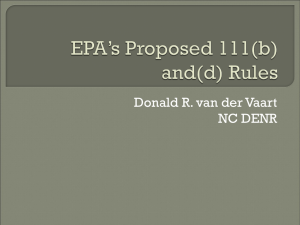Presentation
advertisement

THE IMPLICATION OF ECONOMIC PARTNERSHIP AGREEMENT FOR ACP GROUPS A GENERAL E Q U I L I B R I U M A N A LY S I S OUTLINE Introduction Purpose Previous Researches Methodology and Data Simulation Scenarios Results Conclusion INTRODUCTION Consists 79 countries Accounts for 39% of the Nations in the world Population: 850million 94% in SSA 4% in Caribbean INTRODUCTION o Trade between EU-ACP: non-reciprocal trade preference granted by EU through various Lomé Conventions since 1975. o Lomé preference offered very limited real benefit. -ACP export share into EU deteriorated from 6.7 % in 1976 to 1.4% in 2000. -It did not comply with the WTO article. o In 1996 EU commission published EPA proposal to replace Lomé preference. PURPOSE o Research question: What are the economic consequences of EPA compared to the alternative available? o Aim of the Study: To estimate the impact on trade flows, public revenue, production structure, and welfare. o Limitation: o Higher level of regional and commodity aggregation o Only deals with comparative static effects of tariff changes PREVIOUS RESEARCH 1. Partial equilibrium approach . - Moderate expansion of exports and imports , decrease in intraregional trade, domination of trade creation effect over trade diversion and fiscal revenue loss. 2. General equilibrium approach - Deterioration of balance of trade, expansion of agricultural sector at the expense of the industry sector. - The alternative GSP improves trade balance, increase industrial production and has negligible effect on public revenue. M ETHODOLOGY o Why general equilibrium analysis? -Provides rigorous and theoretically consistent framework of analysis -Well suited to study economy wide effect of tariff changes o GTAP Model: a multi-regional and multi-sector general equilibrium model developed by center for global trade analysis at Purude university. o Standard GETAP: perfect competition and constant returns to scale o Modification to standard GTAP:- Factor Market closure DATA The Model is powered by version 8 database released in 2012 - sources: COMTRADE, IFPRI, IMF, MAcMap, OECD and World bank o It comprise input-output tables, trade taxes, commodity taxes, income taxes and savings of 129 countries covering 57 sectors and 5 factors. o For this study, the database is aggregated into 10 regions, 10 sectors and four factors. REGIONAL AND SECTORAL AGGREGATION OVEVIEW OF ACP-EU ECONOMIES o Global GDP share: 2 % vs 30% o Factor abundance: natural resource vs capital o Trade composition: agriculture and extraction Vs manufacturing and services o Trade relation : asymmetrical and declining in trend o Tariff structure: asymmetrical SIMULATION SCENARIOS RESULT Table 1. Effect on aggregate trade flows (% & million USD) RESULT Table 2. Effect on aggregate tariff revenue (% and Million USD) RESULT Table 3. Effect on industrial value added (%) RESULT Table 4. Trade creation and diversion (million USD) RESULT Figure 1. Welfare effect (million USD) SENSETIVITY ANALYSIS o The sensitivity analysis by varying elasticity of substitution between domestic and imported commodities. o The improvement of welfare is robust in West Africa, SADC and EU at 75% level of confidence only under EPA. o The deterioration of welfare is robust for most ACP groups under the alternative scenario. CONCLUSION o EPA alone would not make all ACP regions better off and it does not leave them worse off than the alternative though it is associated with deindustrialization and substantial public revenue loss. o promoting deep integration within each ACP region would help to counter the adverse effect of EPA on the industry sector and foster the benefit of liberalization. o Future research should focus on integrating other aspects of EPA such as liberalization of service trade, investment and trade facilitation to capture the full impact of EPA proposal. THANK YOU FOR YOUR ATTENTION !











